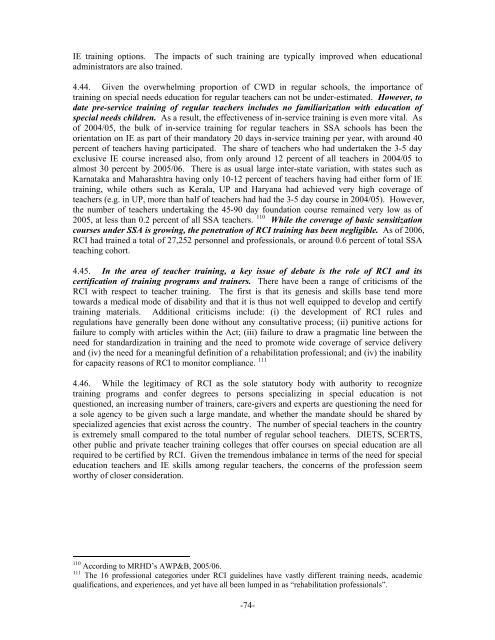People with Disabilities in India: From Commitment to Outcomes
People with Disabilities in India: From Commitment to Outcomes
People with Disabilities in India: From Commitment to Outcomes
You also want an ePaper? Increase the reach of your titles
YUMPU automatically turns print PDFs into web optimized ePapers that Google loves.
IE tra<strong>in</strong><strong>in</strong>g options. The impacts of such tra<strong>in</strong><strong>in</strong>g are typically improved when educational<br />
adm<strong>in</strong>istra<strong>to</strong>rs are also tra<strong>in</strong>ed.<br />
4.44. Given the overwhelm<strong>in</strong>g proportion of CWD <strong>in</strong> regular schools, the importance of<br />
tra<strong>in</strong><strong>in</strong>g on special needs education for regular teachers can not be under-estimated. However, <strong>to</strong><br />
date pre-service tra<strong>in</strong><strong>in</strong>g of regular teachers <strong>in</strong>cludes no familiarization <strong>with</strong> education of<br />
special needs children. As a result, the effectiveness of <strong>in</strong>-service tra<strong>in</strong><strong>in</strong>g is even more vital. As<br />
of 2004/05, the bulk of <strong>in</strong>-service tra<strong>in</strong><strong>in</strong>g for regular teachers <strong>in</strong> SSA schools has been the<br />
orientation on IE as part of their manda<strong>to</strong>ry 20 days <strong>in</strong>-service tra<strong>in</strong><strong>in</strong>g per year, <strong>with</strong> around 40<br />
percent of teachers hav<strong>in</strong>g participated. The share of teachers who had undertaken the 3-5 day<br />
exclusive IE course <strong>in</strong>creased also, from only around 12 percent of all teachers <strong>in</strong> 2004/05 <strong>to</strong><br />
almost 30 percent by 2005/06. There is as usual large <strong>in</strong>ter-state variation, <strong>with</strong> states such as<br />
Karnataka and Maharashtra hav<strong>in</strong>g only 10-12 percent of teachers hav<strong>in</strong>g had either form of IE<br />
tra<strong>in</strong><strong>in</strong>g, while others such as Kerala, UP and Haryana had achieved very high coverage of<br />
teachers (e.g. <strong>in</strong> UP, more than half of teachers had had the 3-5 day course <strong>in</strong> 2004/05). However,<br />
the number of teachers undertak<strong>in</strong>g the 45-90 day foundation course rema<strong>in</strong>ed very low as of<br />
2005, at less than 0.2 percent of all SSA teachers. 110 While the coverage of basic sensitization<br />
courses under SSA is grow<strong>in</strong>g, the penetration of RCI tra<strong>in</strong><strong>in</strong>g has been negligible. As of 2006,<br />
RCI had tra<strong>in</strong>ed a <strong>to</strong>tal of 27,252 personnel and professionals, or around 0.6 percent of <strong>to</strong>tal SSA<br />
teach<strong>in</strong>g cohort.<br />
4.45. In the area of teacher tra<strong>in</strong><strong>in</strong>g, a key issue of debate is the role of RCI and its<br />
certification of tra<strong>in</strong><strong>in</strong>g programs and tra<strong>in</strong>ers. There have been a range of criticisms of the<br />
RCI <strong>with</strong> respect <strong>to</strong> teacher tra<strong>in</strong><strong>in</strong>g. The first is that its genesis and skills base tend more<br />
<strong>to</strong>wards a medical mode of disability and that it is thus not well equipped <strong>to</strong> develop and certify<br />
tra<strong>in</strong><strong>in</strong>g materials. Additional criticisms <strong>in</strong>clude: (i) the development of RCI rules and<br />
regulations have generally been done <strong>with</strong>out any consultative process; (ii) punitive actions for<br />
failure <strong>to</strong> comply <strong>with</strong> articles <strong>with</strong><strong>in</strong> the Act; (iii) failure <strong>to</strong> draw a pragmatic l<strong>in</strong>e between the<br />
need for standardization <strong>in</strong> tra<strong>in</strong><strong>in</strong>g and the need <strong>to</strong> promote wide coverage of service delivery<br />
and (iv) the need for a mean<strong>in</strong>gful def<strong>in</strong>ition of a rehabilitation professional; and (iv) the <strong>in</strong>ability<br />
for capacity reasons of RCI <strong>to</strong> moni<strong>to</strong>r compliance. 111<br />
4.46. While the legitimacy of RCI as the sole statu<strong>to</strong>ry body <strong>with</strong> authority <strong>to</strong> recognize<br />
tra<strong>in</strong><strong>in</strong>g programs and confer degrees <strong>to</strong> persons specializ<strong>in</strong>g <strong>in</strong> special education is not<br />
questioned, an <strong>in</strong>creas<strong>in</strong>g number of tra<strong>in</strong>ers, care-givers and experts are question<strong>in</strong>g the need for<br />
a sole agency <strong>to</strong> be given such a large mandate, and whether the mandate should be shared by<br />
specialized agencies that exist across the country. The number of special teachers <strong>in</strong> the country<br />
is extremely small compared <strong>to</strong> the <strong>to</strong>tal number of regular school teachers. DIETS, SCERTS,<br />
other public and private teacher tra<strong>in</strong><strong>in</strong>g colleges that offer courses on special education are all<br />
required <strong>to</strong> be certified by RCI. Given the tremendous imbalance <strong>in</strong> terms of the need for special<br />
education teachers and IE skills among regular teachers, the concerns of the profession seem<br />
worthy of closer consideration.<br />
110 Accord<strong>in</strong>g <strong>to</strong> MRHD’s AWP&B, 2005/06.<br />
111 The 16 professional categories under RCI guidel<strong>in</strong>es have vastly different tra<strong>in</strong><strong>in</strong>g needs, academic<br />
qualifications, and experiences, and yet have all been lumped <strong>in</strong> as “rehabilitation professionals”.<br />
-74-










